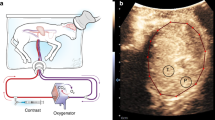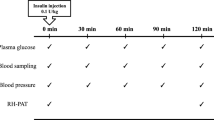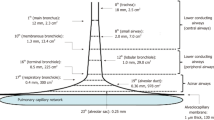Abstract
To determine the circulatory response of the preterm fetus to a sustained hypoxic insult, regional blood flow was measured (microsphere technique) in 12 unanesthetized fetal sheep (0.75 gestation) during a normoxic control period, after 1 h and 8 h of sustained hypoxemia, and after a 1-h recovery period. Associated endocrine changes which might relate to organ-specific changes in blood flow were also assessed. Myocardial and cerebral blood flow were increased by 240 and 90%, respectively, such that oxygen delivery to the heart was well maintained throughout the study, whereas that to the brain was significantly decreased by 8 h of hypoxic study. Regional blood flows for all structures within the brain showed similar percent increases, except that for the pituitary gland, where the increase was much smaller, and that for the choroid plexus, where blood flow actually fell. Whereas blood flow to upper body muscle showed no significant change throughout the study, that to the thyroid was increased by 70% by 1 h of hypoxic study but fell thereafter. Adrenal cortical blood flow relative to that of the medulla was increased 3-fold by 8 h of hypoxic study, indicating a differential effect of sustained hypoxia on these vascular beds. Although pituitary and thyroid blood flows showed no relationship to respective trophic and/or secretory hormones measured, values for adrenal cortical flow relative to medullary flow were well correlated with plasma concentrations of ACTH. It is concluded that the“centralization” of blood flow to vital organs in response to a sustained hypoxic insult is qualitatively similar for both the preterm and near term ovine fetus and that hypoxic regulatory mechanisms may be better protective of the heart. Additionally, a role for the functional activation of the adrenal gland in its blood flow response to sustained hypoxemia is suggested.
Similar content being viewed by others
Log in or create a free account to read this content
Gain free access to this article, as well as selected content from this journal and more on nature.com
or
Abbreviations
- IR:
-
immunoreactive
References
Cohn HE, Sacks EJ, Heymann MA, Rudolph AM 1974 Cardiovascular response to hypoxemia and acidemia in fetal lambs. Am J Obstet Gynecol 120: 817–824
Peeters LL, Sheldon HRE, Jones MD, Makowski EL, Meschia G 1979 Blood flow to fetal organs as a functional of arterial oxygen content. Am J Obstet Gynecol 135: 637–646
Sheldon RE, Peeters LLH, Jones MD, Makowski EL, Meschia G 1979 Redistribution of cardiac output and oxygen delivery in the hypoxic fetal lamb. Am J Obstet Gynecol 135: 1071–1078
Jensen A, Bamford OS, Dawes GS, Hofmeyr GJ, Parkes MJ 1985 Changes in organ blood flow between high and low voltage electrocortical activity and during isocapnic hypoxia in intact and brain stem transected fetal lambs. In: The Physiological Development of the Fetus and Newborn. Academic Press, New York, pp 605–610
Rurak DW, Richardson BS, Patrick JE, Carmichael L, Homan J 1990 Blood flow and oxygen delivery to fetal organs and tissues during sustained hypoxemia. Am J Physiol 258:R1116–R1122
Jensen A, Berger R 1991 Fetal circulatory responses to oxygen lack. J Dev Physiol 16: 181–207
Challis JRG, Richardson BS, Rurak D, Wlodek MD, Patrick JE 1986 Plasma adrenocorticotropic hormone and cortisol and adrenal blood flow during sustained hypoxemia in fetal sheep. Am J Obstet Gynecol 155: 1332–1336
Akagi K, Challis JRG 1990 Threshold of hormonal and biophysical responses to acute hypoxemia in fetal sheep at different gestational ages. Can J Physiol Pharmacol 68: 549–555
Matsuda Y, Patrick J, Carmichael L, Challis J, Richardson B 1992 Effects of sustained hypoxemia on the sheep fetus at midgestation: endocrine, cardio-vascular, and biophysical responses. Am J Obstet Gynecol 167: 531–540
Jones CT, Roebuck MM, Walker DW, Johnston BM 1988 The role of the adrenal medulla and peripheral sympathetic nerves in the physiological responses of the fetal sheep to hypoxia. J Dev Physiol 10: 17–36
Carter AM, Richardson BS, Homan J, Towstoles M, Challis JRG 1993 Regional adrenal blood flow responses to adrenocorticotropic hormone in fetal sheep. Am J Physiol 264:E264–E269
Iwamoto HS, Kaufman T, Kell LC, Rudolph AM 1989 Responses to acute hypoxemia in the fetal sheep at 0.6-0.7 gestation. Am J Physiol 256:H613–H620
Walker AM, Cannata JP, Dowling MH, Ritchie BC, Maloney JE 1979 Age-dependent pattern of autonomic heart rate control during hypoxia in fetal and newborn lambs. Biol Neonate 35: 198–208
Richardson BS, Rurak D, Patrick JE, Homan J, Carmichael L 1989 Cerebral oxidative metabolism during sustained hypoxaemia in fetal sheep. J Dev Physiol 11: 37–43
Fraser M, Liggins GC 1988 Thyroid hormone kinetics during late pregnancy in the ovine fetus. J Dev Physiol 10: 461–471
Polk DH, Reviczky A, Lam RW, Fisher DA 1991 Thyrotropin-releasing hormone in the ovine fetus: ontogeny and effect of thyroid hormone. Am J Physiol 260:E53–E58
Riley SC, Boshier DP, Luu-The V, Labrie F, Challis JRG 1992 Immunohistochemical localization of 3-hydroxysteroid/5-4 isomerase, tyrosine hydroxylase and phenylathanolamine N-methyl transferase in the adrenal gland of fetal sheep throughout gestation and in neonates. J Reprod Fertil 96: 127–134
Makowski EL, Schneider JM, Tsoulos NG, Colwill JR, Battaglia FC, Meschia G 1972 Cerebral blood flow, oxygen consumption and glucose utilization of fetal lambs in utero. Am J Obstet Gynecol 114: 292–303
Asano H, Homan J, Carmichael L, Korkola S, Richardson B 1994 Cerebral metabolism during sustained hypoxemia in preterm fetal sheep. Am J [Illegible Text] Gynecol 170: 939–944
Challis JRG, Brooks AN 1989 Maturation and activation of hypothalamic-pituitary-adrenal function in fetal sheep. Endocr Rev 10: 182–204
Fraser M, Gunn TR, Butler JH, Johnston BM, Gluckman PD 1985 Circulating thyrotropin in the ovine fetus: evidence for pulsatile release and the effect of hypothermia in utero. Pediatr Res 19: 208–212
Jones MD, Sheldon RE, Peeters LL, Makowski EL, Meschia G 1978 Regulation of cerebral blood flow in the ovine fetus. Am J Physiol 235:H162–H166
Rosenberg AA, Harris AP, Koehler RC, Hudak ML, Tryastman RJ, Jones MD 1986 Role of O2 hemoglobin affinity in the regulation of cerebral blood flow in fetal sheep. Am J Physiol 251:H56–H62
Gleason CA, Hamm C, Jones MD 1990 Effect of acute hypoxemia on brain blood flow and oxygen metabolism in immature fetal sheep. Am J Physiol 258:H1064–H1069
Richardson BS, Carmichael L, Homan J, Gagnon R 1989 Cerebral oxidative metabolism in lambs during perinatal period: relationship to [Illegible Text] state. Am J Physiol 257:R1251–R1257
Buckberg GD, Luck JC, Payne DB, Hoffman JIE, Archie JP, Fixler DE 1971 Some sources of error in measuring regional blood flow with radioactive microspheres. J Appl Physiol 31: 598–604
Dole WM, Jackson DL, Rosenblatt JI, Thompson WL 1982 Relative error and variability in blood flow measurements with radiolabeled microspheres. Am J Physiol 243:H371–H378
Jensen A, Bamford OS, Dawes GS, Hofmeyer G, Parkes MJ 1986 Changes in organ blood flow between high and low voltage electrocortical activity in fetal sheep. J Dev Physiol 8: 187–194
Hanley DF, Wilson DA, Traystman RJ 1986 Effect of hypoxia and hypercapnia on neurohypophyseal blood flow. Am J Physiol 250:H7–H15
Fisher DJ, Heymann MA, Rudolph AM 1982 Fetal myocardial oxygen and carbohydrate consumption during acutely induced hypoxemia. Am J Physiol 242:H657–H661
Fisher DJ, Heymann MA, Rudolph AM 1982 Regional myocardial blood flow and oxygen delivery in fetal, newborn and adult sheep. Am J Physiol 243:H729–H731
Fisher DA, Polk DH 1994 Development of the fetal thyroid system. In: Textbook of Fetal Physiology. Oxford University Press, Oxford, pp 359–368
Author information
Authors and Affiliations
Additional information
Supported by the Medical Research Council of Canada.
Rights and permissions
About this article
Cite this article
Richardson, B., Korkola, S., Asano, H. et al. Regional Blood Flow and the Endocrine Response to Sustained Hypoxemia in the Preterm Ovine Fetus. Pediatr Res 40, 337–343 (1996). https://doi.org/10.1203/00006450-199608000-00024
Received:
Accepted:
Issue date:
DOI: https://doi.org/10.1203/00006450-199608000-00024



